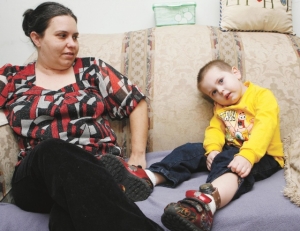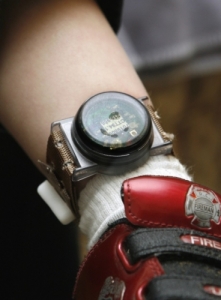Making sure lost children, seniors have best chance of being found
By Catharin Shepard
Published in News on January 6, 2009 1:46 PM

News-Argus/GREG SOUSA
Jennifer Avery sits with her 4-year-old son Joey, who has autism, as he displays the Care Trak tracking device that he wears on his ankle. The personal tracking system is the crux of a new partnership between the Arrington and Mar-Mac volunteer fire departments and North Carolina Project Lifesaver, a search and rescue task force that uses Care Trak to locate children and adults with special needs who wander away from home.

News-Argus/GREG SOUSA
Four-year-old Joey Avery, who suffers from autisim, displays the Care Trak tracking device that he wears on his ankle. The personal tracking system is the crux of a new partnership between the Arrington and MarMac Volunteer Fire Departments and North Carolina Project Lifesaver, a search and rescue task force that uses Care Trak to locate children and adults with special needs who wander away from home.
It might look like a cheap, stripped-down plastic watch, but the Care Trak device strapped to 4-year-old Joey Avery's ankle cost about $240.
The boxy receiver that works with the little bracelet resembles a clunky handheld radio and costs more than $2,500.
But for Jennifer Avery and other parents of children with autism, the equipment could one day mean the difference between knowing their child is safe and losing him or her forever.
The personal tracking system is the crux of a new partnership between the Arrington and Mar-Mac Volunteer Fire Departments and North Carolina Project Lifesaver, a search and rescue task force that uses the Care Trak system to locate children and adults with special needs who wander away from home.
"Fortunately, we haven't had to 'use it' use it," said Mrs. Avery, but said she is very glad for the bracelet her son has worn for more than a year.
When Mrs. Avery told workers at her son's service provider company, A Small Miracle, about Care Trak, the company and the Autism Society teamed together to purchase and donate one of the Care Trak receiver systems to the fire department.
The Arr-Mac search and rescue squad stepped up to the training to become the Wayne County point of contact for N.C. Project Lifesaver. Members learned to use the Care Trak technology and will keep the receiver on hand until it is needed.
"This is just another logical step for us," said Fire Chief Randy Rogers at Arrington VFD. "We've got the technical know-how on the search and rescue."
The Arr-Mac team has been called out about a dozen times to search and rescue missions across the state. Sadly for the families of the missing persons, not all of the searches had favorable conclusions.
"Some did, some didn't," Rogers said.
With the Care Trak receiver, rescuers have a better chance of finding a missing person quickly, said Major Derek Ellis, an officer with N.C. Project Lifesaver.
"It makes a tremendous difference. The average search time is 30 minutes (with the bracelet)," said Ellis. "For a missing person who does not have Care Trak, it's 16 hours."
After the first 24 hours, the chance of finding a missing person alive decreases by 50 percent, said Ellis.
With the bracelet, "You're looking at a very big change in that," he said.
Ellis visited Goldsboro on Saturday to make test runs with the Arr-Mac team's new receiver and train them in how to use it in the field.
N.C. Project Lifesaver, a 501(c)(3) nonprofit organization, is not affiliated with the Care Trak company, but they do partner with federal, state and local agencies throughout North Carolina to bring missing persons home safely.
The children served by A Small Miracle have unique needs that would make finding them especially difficult if they wandered away from home, said Ann Newsome, vice president of the company.
"Most of the children we serve are not able to communicate," she said.
Thanks to the donation, Wayne County residents with special needs can join the more than 1,600 people statewide who wear the bracelets.
Mrs. Avery's son is the only child in Wayne County wearing the bracelet so far, but A Small Miracle hopes to reach out to the Goldsboro Council on Aging and make families of Alzheimer's patients aware of the availabile technology, Mrs. Newsome said.
The Goldsboro branch of the Autism Society also helped purchase the $2,500 receiver.
Wayne County will be one of about 50 N.C. counties that partner with N.C. Project Lifesaver, and will have access to the agency's 26 dedicated search and rescue members and four aircraft. In return, the Arr-Mac team may be called out to use the Care Trak receiver to find missing people in surrounding counties.
The equipment has helped so many people return home, Ellis said couldn't give an exact number.
"We do so many of them, it's unreal," he said.
The Care Trak bracelets are worn on the wrist like a watch or strapped around the ankle, secured by tamper-proof bands that must be cut off and replaced once a month to change the battery. The bracelet transmitter produces a constant signal that can be picked up by the mobile tracking device up to a mile away.
The system works much like an FM radio station, according to the manufacturer's web site. Since it uses telemetry instead of the satellite-based technology popular in GPS devices, the bracelets will work even in bad weather. The signal will not be lost if the wearer goes into a building or wooded area, though reception may be reduced if the missing person is in a heavily forested place.
